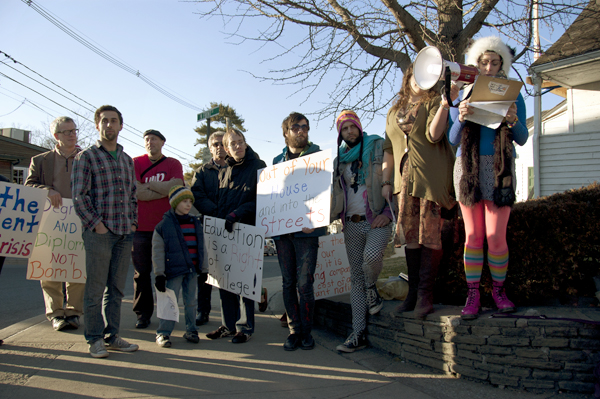

On Saturday, March 10, New Paltz and Hudson Valley residents joined together at the Occupy Education march and rally to protest the lack of funds available for public education.
A group of nearly 50 protestors came out to show their disapproval with how public education has been “de-prioritized” in the state budget. The event began with a march through the village that came to the SUNY New Paltz campus.
After the march, a rally took place on the cross-section of Main and Church Street. Speakers representing different local areas and levels discussed their concerns with the state and federal government’s treatment of education throughout the past few years.
New Paltz resident Amanda Sisenstein organized the event. She said she was inspired to plan the event after seeing how stressed educators and students are in the current economy.
“I’ve always been concerned with education,” Sisenstein said. “When I was in [the] New York Public Interest Research Group (NYPIRG) I took a huge focus on education issues and saw that a lot of students who come out of college have huge debts. Teachers are under a lot of pressure with larger class sizes and they don’t get paid enough.”
Protestors at the rally had signs like “Less Prisons, More Schools” and “If You Found Oil in My School, Would You Fund It?”
New Paltz alumnus Max Richmond said he attended the event to not only show his support for Sisenstein, but because he believes the government needs to reevaluate its priorities when it comes to allocating money.
“There’s no money to teach our children and it’s sick,” Richmond said. “We need to raise awareness. We’re a scientific and intellectual powerhouse, and we can only stay that way if we give more money to our public education systems.”
Amy Kletter, an elementary teacher for the Hyde Park School District, spoke at the event and has started a letter writing campaign with hopes that students and parents alike will address their concerns to New York Gov. Andrew Cuomo.
According to Kletter, Cuomo currently holds an approval rating just below 70 percent, but his education approval rating stands at 30 percent. Kletter said she believes that with enough pressure, Cuomo will “cave.”
“Cuomo is a politician and all politicians want to get re-elected,” Kletter said. “Education is a weak spot for Cuomo and if we can get enough people to speak up, he will give in.”
SUNY New Paltz Associate Professor Julie Gorlewski and Executive Director of Alliance for Quality Education Billy Easton both said current standardized testing formats represent a “flawed” system. Easton also said the lack of funds forces school districts to cut programs like college prep courses and make kindergarten into a half-day program.
Kletter said the cutting of programs would create a “massive snowball effect” that would be detrimental for students and teachers within the public education system.
“With larger class sizes, teachers are under a massive amount of pressure to make sure all of their students are doing OK,” Kletter said.
Kletter said she hopes the state government will change the way money is allocated. Instead of giving money to schools based on performance, Kletter said.
“What ends up happening is schools in wealthier areas get the money while schools in poorer areas get closed out,” Kletter said. “This continues the one percent and we need to change it.”
While most speakers at the event were adults in the public education system, school children in the area also came to call for increased funding.
“I’m really afraid the schools won’t get the money they need,” 8-year-old New Paltz resident Ezra Engel-Di Mauro said. “I really believe education is a good thing and I don’t want to see more prisons than schools.”
Sisenstein said with not much time left, she encourages everyone to make phone calls and write letters to make change.
“Teachers and students alike are suffering,” Sisenstein said. “We have to make a change for the better now.”
